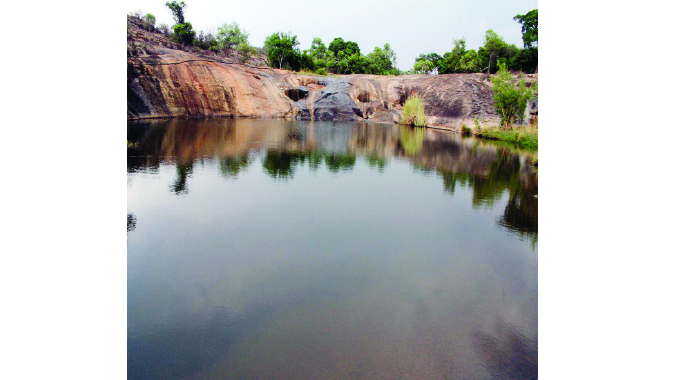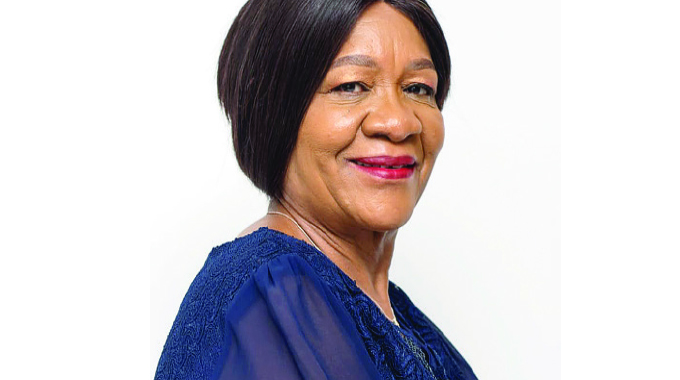Diana’s Pools: an untapped tourism gem

Mashudu Netsianda, Senior Reporter
TUCKED in the heart of rural Matobo district in Matabeleland South, Diana’s Pools, which is surrounded by picturesque dome mountains worn down by relentless erosion, is an untapped tourism gem.
With its raw and uncluttered beauty featuring numerous granite rock formations with outstanding collection of rock paintings and an exciting variety of plant life, Diana’s Pools is a must visit.
It is a great place to either spend a day exploring the beauty of rural Zimbabwe, relaxing and picnicking or to stay for a night enjoying the tranquillity of mother nature in a peaceful environment.
The pools, which are locally known as “Embizeni” (Place of the Pots) are set in rocks with cascades, slides and sand along the river edge. The name “Embizeni” is derived from the potholes rain water has carved into the granite rocks over a lengthy geological period.
Diana’s Pools was named after the wife of the first Native Commissioner in the area, JP Richardson. The area has several pools which vary in size with the smallest as big as a large pothole.
Surrounded by a sea of barren hills, Diana’s Pools offers a refreshing scenery. It is a charming natural wonder with many rock outcrops featuring boulders of various shapes and sizes.
It is strategically located close to Bulawayo, and as one drives down along the Bulawayo-Beitbridge Road, they branch off at Mawabeni in Umzingwane district. The gravel road leading to Diana’s Pools is in good condition.
Diana’s Pools is part of the Matobo Hills, which is a protected area by virtue of their outstanding universal value as a United Nations Educational, Scientific and Cultural Organisation (UNESCO) World Heritage site.
The area exhibits a profusion of distinctive rock landforms rising above the granite shield that covers much of Zimbabwe. The Matobo Hills have one of the highest concentrations of rock art in Southern Africa dating back at least 13 000 years.
The paintings illustrate evolving artistic styles and also socio-religious beliefs of the Bushmen bearing testimony to their rich cultural tradition.
The large boulders provide abundant natural shelters and have been associated with human occupation from the early Stone Age right through to early historical times.
The Matobo Hills continue to provide a strong focus for the local community, which still uses shrines and sacred places closely linked to traditional activities.
Diana’s Pools is also a fisherman’s paradise due to its proximity to the nearby Mtshabezi River and Malunika Dam.
Visitors to the site will enjoy the riverine habitat around the chalets, rock climbing and viewing the numerous San rock art sites in the surrounding area and exploring the shallow pool with sandy beach.
Some of the sites worth visiting within the vicinity of Diana’s Pools include Rhodes Indaba Site, a famous anthill where Cecil John Rhodes stood when he addressed the Ndebele indunas as he negotiated for peace on August 21, 1896.
This was after the Ndebeles rose against British colonialism during the First Umvukela/Chimurenga. The site falls under the National Museums and Monuments of Zimbabwe.
There is also the magnificent Nyunteya Cave which contains 13 grain bins, several rock paintings and the Orbicular granite site where there is a rare granite rock formation with rounded (orbicular) intrusions.
For overnight accommodation there is Embizeni Lodge with outdoor braai spots and self-catering facilities for visitors as they undertake various activities at Diana’s Pools.
Former Umzingwane Publicity Association treasurer and rural development consultant Mr Piet te Velde owns the chalets, which can accommodate up to 12 people.
“Diana’ Pools has great tourism potential and my dream has always been to develop eco-tourism in this beautiful district. My future plan is to rebrand the chalets so that Diana’s Pools is an ideal destination of choice for tourists who are interested in cultural tourism and interacting with local communities including exploring the place,” he said.
Diana’s Pools is situated about 20km from the Matopos National Park.
“There is no road linking Diana’s Pools and Matopos National Park and therefore what we are actually trying to do now is to promote organised walks which take about three days allowing tourists to interact with locals,” said Mr te Velde.
“I believe cultural tourism has a potential income for locals and they should also be educated on how to host visitors,” he said
Mr te Velde urged locals to turn the place into a community-based tourism destination where tourists can pay a minimal entry fee to access the pools. Currently, there are no entry fees for visitors.

The caretaker of the place, Mr Kevin Nxumalo said visitors to the scenic area include mountain bikers, students on education tours, backpackers and cultural tourists among other groups of holidaymakers.
“This place is beautiful but lacks aggressive marketing. Before the Covid-19 lockdown we used to get quite a number of visitors including foreign tourists. We usually get people coming here to camp for days while others come to conduct sporting activities such as mountain biking, motorbike racing, swimming and sightseeing,” he said.
Mr Nxumalo said Diana’s Pools is also a hit with cultural and religious tourists who occasionally visit the place for various rites.
He said their major concern was lack of security which has resulted in vandals destroying infrastructure at the recreational site.
“Diana’s Pools is a beautiful place but sadly we have a challenge of some people who don’t treasure this place. They have been vandalising infrastructure such as the site community kiosk and public toilets,” he said.
When Chronicle news crew visited the place, it observed that some window panes for the kiosk have been smashed and the thatching roof of the ablution facilities has been removed.
“This place has great potential in terms of tourism because we have paintings, caves, grain bins and it’s also situated near the Cecil John Rhodes Indaba Site. We need to educate our people about the importance of preserving such places for future generations,” said Mr Nxumalo. — @mashnets











Comments